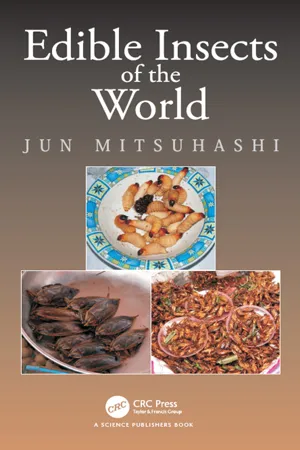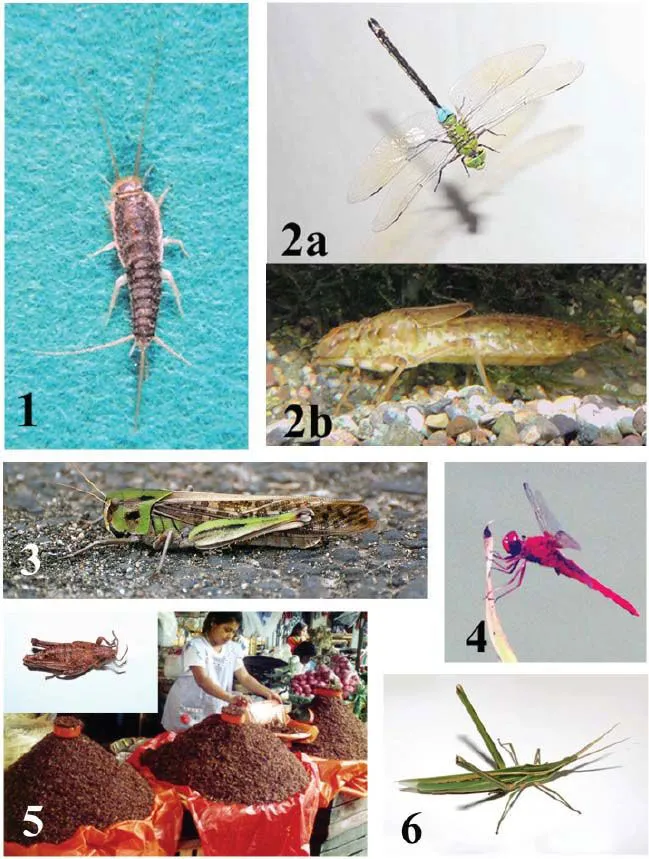
- 296 pages
- English
- ePUB (mobile friendly)
- Available on iOS & Android
eBook - ePub
Edible Insects of the World
About this book
The first book on entomophagy written in this manner, Edible Insects of the World is an enumeration of 2,141 species of edible insects. For the reader's convenience, insect names are arranged much like a dictionary, first by taxonomic group and then by country. In addition to taxonomic and location information, entries contain applicable details about the history of entomophagy, collecting, cooking, and medicinal uses.
Frequently asked questions
Yes, you can cancel anytime from the Subscription tab in your account settings on the Perlego website. Your subscription will stay active until the end of your current billing period. Learn how to cancel your subscription.
No, books cannot be downloaded as external files, such as PDFs, for use outside of Perlego. However, you can download books within the Perlego app for offline reading on mobile or tablet. Learn more here.
Perlego offers two plans: Essential and Complete
- Essential is ideal for learners and professionals who enjoy exploring a wide range of subjects. Access the Essential Library with 800,000+ trusted titles and best-sellers across business, personal growth, and the humanities. Includes unlimited reading time and Standard Read Aloud voice.
- Complete: Perfect for advanced learners and researchers needing full, unrestricted access. Unlock 1.4M+ books across hundreds of subjects, including academic and specialized titles. The Complete Plan also includes advanced features like Premium Read Aloud and Research Assistant.
We are an online textbook subscription service, where you can get access to an entire online library for less than the price of a single book per month. With over 1 million books across 1000+ topics, we’ve got you covered! Learn more here.
Look out for the read-aloud symbol on your next book to see if you can listen to it. The read-aloud tool reads text aloud for you, highlighting the text as it is being read. You can pause it, speed it up and slow it down. Learn more here.
Yes! You can use the Perlego app on both iOS or Android devices to read anytime, anywhere — even offline. Perfect for commutes or when you’re on the go.
Please note we cannot support devices running on iOS 13 and Android 7 or earlier. Learn more about using the app.
Please note we cannot support devices running on iOS 13 and Android 7 or earlier. Learn more about using the app.
Yes, you can access Edible Insects of the World by Jun Mitsuhashi in PDF and/or ePUB format, as well as other popular books in Sciences biologiques & Biologie. We have over one million books available in our catalogue for you to explore.
Information
PART I
THE LIST OF EDIBLE INSECTS IN ORDER OF TAXONOMIC GROUP*
1. THYSANURA (Silverfish) [2]
Lepismatidae (Silverfish) (2)
Ctenolepisma villosa (oriental silverfish) (PL I-1) China: This species is used for curing child paralysis, inducing abortion (Li 1596). South Korea: The roasted powder of the adults are used for treating lumbago, difficulty in urination, etc. in North Chungcheong and North Gyeongsang Provinces (Okamoto and Muramatsu 1922).
Lepisma saccharina (silverfish, bookworms) China: This species is used as a remedy for rheumatism (Zimian et al. 1997). Japan: The Japanese name is seiyō-shimi. This species is used for diuretic purposes, treatment of paralysis, etc. (Umemura 1943, Shiraki 1958).
2. EPHEMEROPTERA (Mayflies) [7]
Baetidae (Small mayflies) (2)
Baetis sp. Mexico: The Mexican name is moscas de mayo. The larvae are eaten in Estado de Mexico (Ramos-Elorduy et al. 1998).
Cloeon dipterum (pond olive) Japan: The Japanese name is futaba-kagerō. The larvae are roasted with other aqueous insects. They are rich in fat, and most people like to eat them (Kuwana 1930).

Plate I. 1. Ctenolepisma villosa adult. Body length: 8–9 mm (cf. p.1) (Photo: K. Umeya, Tsukuba, Japan); 2. Anax parthenope julius. a: Adult ♂. Length of abdomen: 50 mm. b: Larva. Body length: 43 mm (cf. p.4); 3. Locusta migratoria adult. Body length: 45 mm (cf. p.17); 4. Crocothemis servilia adult. Length of abdomen: 28 mm (cf. p.6); 5. A girl selling cooked grasshoppers at Oaxaca, Mexico. Insert: A close-up of the grasshopper, Sphenarium sp. Body length: 30 mm (cf. p.26); 6. Acrida cinerea adult ♀. Body length: 80 mm (cf. p. 10).
Cloeon kimminsi The larvae and the adults are eaten roasted by the Nishi people in Arunachal Pradesh State, India (Singh et al. 2007).
Caenidae (Small square-gill mayflies) (2)
Caenis kungu In Malawi, people living in the northern part of Lake Malawi catch the adults, and make blocks called “kungu” by pressing them. These blocks are said to taste like caviar or salted grasshoppers (Ealand 1915).
Povilia adusta In Malawi, people collect the adults and press them to make insect blocks, which also contain several other species such as chironomids (van Huis 2008).
Ephemerellidae (Spiny crawler mayflies) (1)
Ephemerella jianghongensis The larvae are frizzled or fried with meat of frogs or fish in the Yunnan Province, China. The adults are frizzled with eggs (Chen and Feng 1999).
Ephemeridae (Burrowing mayflies) (2)
Ephemera danica The larvae and the adults are roasted by the Nishi people in Arunachal Pradesh State, India (Singh et al. 2007). The roasted or boiled larvae are used as a remedy for stomach disorders (Chakravorty et al. 2011).
Ephemera strigata The Japanese name is mon-kagerō. In Japan, the larvae were roasted with other aqueous insects. They were rich in fat, and most people liked to eat them (Kuwana 1930).
Ephemera sp. Mexico: The Mexican name is mosca de mayo. The larvae are eaten in Mexico (Ramos-Elorduy et al. 1998).
3. ODONATA (Dragonflies) [40]
Aeschnidae (Hawker dragonflies) (8)
Aeschna brevifrons The larvae are consumed by the Quichua people in Ecuador (Onore 1997).
Aeschna marchali The larvae are consumed by the Quichua people in Ecuador (Onore 1997).
Aeschna mixta The larvae and adults are eaten raw by the Karbi and Rengma Naga people in Assam State, India (Ronghang and Ahmed 2010).
Aeschna multicolor (common blue darner) Mexico: The Mexican name is padrecitos. The larvae are eaten (Ramos-Elorduy et al. 1998). USA: The larvae were eaten by the native Americans of the arid regions of the West (Ebeling 1986).
Aeschna peralta The larvae are consumed by the Quichua people in Ecuador (Onore 1997).
Aeschna spp. India: The larvae whose vernacular name is anga-mechep are consumed by the Ao-Naga people (Meyer-Rochow 2005). Mexico: Mexican name is padrecitos. The larvae are eaten (Ramos-Elorduy et al. 1998). Thailand: People living in Northeast Thailand eat the larvae called darner (Hanboonsong et al. 2000).
Anax guttatus The larvae and adults are boiled or roasted in Thailand (Bristowe 1932).
Anax parthenope julius (lesser emperor dragonfly) (PL I-2a,b) Japanese name is gin-yanma. In Japan, the larvae were roasted and the adults were spit-roasted in the Nagano Prefecture (Takagi 1929a). China: The larvae are fried without coating (Mao 1997, Umeya 2004). This species is also used as an antidote (Zimian et al. 1997).
Anax sp. Indonesia: The larvae and adults of some species belonging to this genus are fried, boiled or roasted. It is also used as an ingredient of botok cuisine (Clausen 1954, Pemberton 1995). Mexico: Mexican name is padrecitos. The larvae and the adults are consumed in Toluca (Ramos-Elorduy and Pino 1990).
Coryphaeschna adnexa The larvae are consumed by the Oyavalo and Quichua people in Ecuador (Onore 1997).
Rhinoaeschna →Aeschna
Agrionidae (Narrow-winged damselflies) (1)
Ceriagrion sp. The larvae of a species belonging to this genus are eaten in Laos, Myanmar and Vietnam (Yhoung-Aree and Viwatpanich 2005) and Thailand (Hanboonsong et al. 2000).
Calopterygidae (Broad-winged damselflies) (0)
Hetaerina sp. The Yekuana people in Alto Orinoco area, Venezuela eat the larvae of a species belonging to this genus (Araujo and Beserra 2007).
Mnesarete sp. The Yekuana people in Alto Orinoco area, Venezuela eat the larvae of a species belonging to this genus (Araujo and Beserra 2007).
Coenagrionidae (Damselflies) (0)
Argia sp. The Yekuana people in Alto Orinoco area, Venezuela eat the larvae of a species belonging to this genus (Araujo and Beserra 2007).
Enallagma sp. In Arunachal Pradesh State, India, the larvae and adults of a species, which is called esh tat tani by the Galo tribes or soko yoyo by the Nishi tribes, are eaten. People prefer the larvae to the adults. They eat the dragonflies raw with bamboo shoots. When the adults are eaten, their wings are removed before eating (Chakravorty et al. 2011).
Cordulegasteridae (Biddies) (1)
Anotogaster sieboldii The Japanese name is oni-yanma. The larvae are eaten roasted and the adults are eaten spit-roasted in the Nagano Prefecture, Japan (Takagi 1929a).
Cordulegaster sp. The larvae are eaten fried in oil by the Meeteis people in Nagaland State, India (Meyer-Rochow 2005).
Corduliidae (Green-eyed skimmers) (2)
Epophtalmia vittigera bellicose The larvae of this species are boiled or fried in Thailand (Hanboonsong et al. 2000).
Lauromacromia dubitalis The Yekuana people in Alto Orinoco area, Venezuela eat the larvae (Araujo and Beserra 2007).
Macromia sp. A species belonging to this genus is boiled or fried in Thailand ...
Table of contents
- Cover
- Half Title
- Title Page
- Copyright Page
- Table of Contents
- Preface
- Part I: The List of Edible Insects in Order of Taxonomic Group
- Part II: List of Edible Insects by Countries or Districts
- Part III